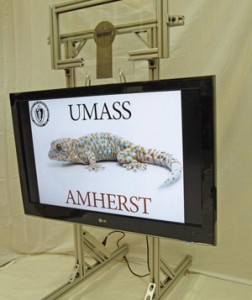It appears that researchers at the University of Massachusetts at Amherst have found a way to make their ‘Geckskin’, an adhesive product modeled on a gecko’s feet (a lizard famously able to stick to an object by a single toe), adhere to the widest range of surfaces yet (from an April 17, 2014 University of Massachusetts news release [also on EurekAlert but dated April 18, 2014]),
The ability to stick objects to a wide range of surfaces such as drywall, wood, metal and glass with a single adhesive has been the elusive goal of many research teams across the world, but now a team of University of Massachusetts Amherst inventors describe a new, more versatile version of their invention, Geckskin, that can adhere strongly to a wider range of surfaces, yet releases easily, like a gecko’s feet.
“Imagine sticking your tablet on a wall to watch your favorite movie and then moving it to a new location when you want, without the need for pesky holes in your painted wall,” says polymer science and engineering professor Al Crosby. Geckskin is a ‘gecko-like,’ reusable adhesive device that they had previously demonstrated can hold heavy loads on smooth surfaces such as glass.
‘Geckskin’ first mentioned here in an April 3, 2012 posting features a different approach to mimicking the gecko’s adhesiveness; most teams are focused on the nanoscopic hairs on the gecko’s feet while the researchers at the University of Massachusetts have worked on ‘draping’,
The University of Massachusetts team’s innovation (from the Feb. 17, 2012 news item),
The key innovation by Bartlett and colleagues was to create an integrated adhesive with a soft pad woven into a stiff fabric, which allows the pad to “drape” over a surface to maximize contact. Further, as in natural gecko feet, the skin is woven into a synthetic “tendon,” yielding a design that plays a key role in maintaining stiffness and rotational freedom, the researchers explain.
Importantly, the Geckskin’s adhesive pad uses simple everyday materials such as polydimethylsiloxane (PDMS), which holds promise for developing an inexpensive, strong and durable dry adhesive.
The UMass Amherst researchers are continuing to improve their Geckskin design by drawing on lessons from the evolution of gecko feet, which show remarkable variation in anatomy. “Our design for Geckskin shows the true integrative power of evolution for inspiring synthetic design that can ultimately aid humans in many ways,” says Irschick.
Two years later, the researchers have proved their concept across a range of surfaces (from the 2014 news release),
In Geckskin, the researchers created this ability by combining soft elastomers and ultra-stiff fabrics such as glass or carbon fiber fabrics. By “tuning” the relative stiffness of these materials, they can optimize Geckskin for a range of applications, the inventors say.
To substantiate their claims of Geckskin’s properties, the UMass Amherst team compared three versions to the abilities of a living Tokay gecko on several surfaces, as described in their journal article this month. As predicted by their theory, one Geckskin version matches and even exceeds the gecko’s performance on all tested surfaces.
Irschick points out, “The gecko’s ability to stick to a variety of surfaces is critical for its survival, but it’s equally important to be able to release and re-stick whenever it wants. Geckskin displays the same ability on different commonly used surfaces, opening up great possibilities for new technologies in the home, office or outdoors.”
Here’s a link to and a citation for the paper,
Creating Gecko-Like Adhesives for “Real World” Surfaces by Daniel R. King, Michael D. Bartlett, Casey A. Gilman, Duncan J. Irschick, and Alfred J. Crosby. Advanced Materials. Article first published online: 17 APR 2014 DOI: 10.1002/adma.201306259
© 2014 WILEY-VCH Verlag GmbH & Co. KGaA, Weinheim
This article is behind a paywall.
The researchers have produced a video (silent) where they demonstrate the Geckskin’s adhesive properties over a number of different surfaces. At seven minutes or so, it runs a bit longer than the videos I embed here but you can find it at http://www.youtube.com/watch?v=SayqhqTZoxI&feature=youtu.be.

